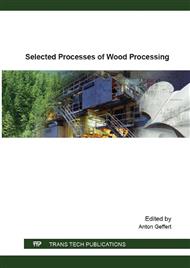p.44
p.50
p.59
p.65
p.77
p.82
p.90
p.96
p.104
Effect of Essential Oils on the Mechanical Properties of Lignocellulosic Materials
Abstract:
Biodeterioration of lignocellulosic materials is a worldwide problem and it causes a great damage especially to unique manuscripts and books stored in libraries. These materials are permanently subject to suffering from physical, chemical, and/or biological changes. Biological deterioration by microorganisms (bacteria and fungi) causes undesirable changes on material properties. Paper made by vegetal fibers, functional additives (glue, optical polishers, consolidating nts), and inks with organic bindings are used as sources of nutrients. Using of EOs (essential oils) for protection against microorganisms appears to be an option, because antimicrobial effects of the main compounds of EOs were proven. This work analyzes the antimicrobial stability of 2 essential oils (citral and linalyl acetate), as well as their stability of mechanical properties, in selected lignocellulosic materials (soft wood and hard wood kraft pulp, softwood sulphite pulp). Some parts of samples were subjected only to the condition of the EOs, other samples were firstly treated by accelerated ageing. Last samples were exposed to the accelerated ageing and afterwards treated by EOs. From the mechanical properties measuring of samples it is possible to state that in some SAJ samples the influence of EOs vapour is positive. This was monitored even when the samples were treated by accelerated ageing.
Info:
Periodical:
Pages:
77-81
Citation:
Online since:
April 2016
Authors:
Keywords:
Price:
Сopyright:
© 2016 Trans Tech Publications Ltd. All Rights Reserved
Share:
Citation:


